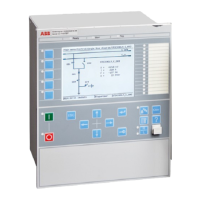to the load on the LV side, or it may be divided between the LV and the HV side. In the latter
case, the part of I
C
that goes to the HV side will divide between the two transformers and it
will be measured with opposite direction for T2 and T1. This in turn would be misinterpreted as
a circulating current, and would upset a correct calculation of I
cc
. Thus, if the actual connection
is as in the left figure the capacitive current I
C
needs to be compensated for regardless of the
operating conditions and in ATCC this is made numerically. The reactive power of the
capacitor bank is given as a setting Q1, which makes it possible to calculate the reactive
capacitance:
EQUATION1871 V1 EN-US (Equation 124)
Thereafter the current I
C
at the actual measured voltage U
B
can be calculated as:
EQUATION1872 V1 EN-US (Equation 125)
In this way the measured LV currents can be adjusted so that the capacitor bank current will
not influence the calculation of the circulating current.
Three independent capacitor bank values Q1, Q2 and Q3 can be set for each transformer in
order to make possible switching of three steps in a capacitor bank in one bay.
Power monitoring
SEMOD159053-251 v4
The level (with sign) of active and reactive power flow through the transformer, can be
monitored. This function can be utilized for different purposes for example, to block the
voltage control function when active power is flowing from the LV side to the HV side or to
initiate switching of reactive power compensation plant, and so on.
There are four setting parameters
P>
,
P<
,
Q>
and
Q<
with associated outputs in TR8ATCC and
TR1ATCC function blocks PGTFWD, PLTREV, QGTFWD and QLTREV. When passing the pre-set
value, the associated output will be activated after the common time delay setting
tPower
.
The definition of direction of the power is such that the active power P is forward when power
flows from the HV-side to the LV-side as shown in figure
159. The reactive power Q is forward
when the total load on the LV side is inductive ( reactance) as shown in figure 159.
ATCC
IED
HV-side
Pforward
LV-side
IEC06000536_1_en.vsd
Qforward
(inductive)
IEC06000536 V2 EN-US
Figure 159: Power direction references
Section 13 1MRK 511 358-UEN A
Control
312
Application manual

